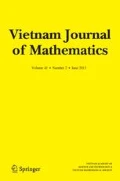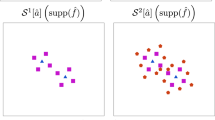Abstract
The iterative rational Krylov algorithm (IRKA) is a popular approach for producing locally optimal reduced-order \({\mathscr{H}}_{2}\)-approximations to linear time-invariant (LTI) dynamical systems. Overall, IRKA has seen significant practical success in computing high fidelity (locally) optimal reduced models and has been successfully applied in a variety of large-scale settings. Moreover, IRKA has provided a foundation for recent extensions to the systematic model reduction of bilinear and nonlinear dynamical systems. Convergence of the basic IRKA iteration is generally observed to be rapid—but not always; and despite the simplicity of the iteration, its convergence behavior is remarkably complex and not well understood aside from a few special cases. The overall effectiveness and computational robustness of the basic IRKA iteration is surprising since its algorithmic goals are very similar to a pole assignment problem, which can be notoriously ill-conditioned. We investigate this connection here and discuss a variety of nice properties of the IRKA iteration that are revealed when the iteration is framed with respect to a primitive basis. We find that the connection with pole assignment suggests refinements to the basic algorithm that can improve convergence behavior, leading also to new choices for termination criteria that assure backward stability.





Similar content being viewed by others
Notes
For the reader’s convenience, here we actually reproduce the proof of the Sherman–Morrison determinant formula.
Since the matrix is a rank one perturbation of the diagonal matrix, all eigenvalues can be computed in O(r2) operations by specially tailored algorithms.
The shifts (eigenvalues) are naturally considered as equivalence classes in \(\mathbb {C}^{r}/\mathbb {S}_{r}\).
We tacitly assume that throughout the iterations all shifts are simple.
We should point out here that the dimensions n and r are rather small in all reported numerical experiments in [35].
This is the classical backward error interpretation.
Let \(\mathbf {A} \in \mathbb {C}^{n\times n}\) and \(\mathbf {b}\in \mathbb {C}^{n}\). Then, the pair (A,b) is called controllable if \(\text {rank}\left [\begin {array}{cccc}\mathbf {b} & \mathbf {A} \mathbf {b} & {\dots } & \mathbf {A}^{n-1}\mathbf {b} \end {array}\right ]=n.\)
References
Ahuja, K., Benner, P., de Sturler, E., Feng, L.: Recycling BiCGSTAB with an application to parametric model order reduction. SIAM J. Sci. Comput. 37, S429–S446 (2015)
Ahuja, K., de Sturler, E., Gugercin, S., Chang, E.: Recycling BiCG with an application to model reduction. SIAM J. Sci. Comput. 34, A1925–A1949 (2012)
Antoulas, A.C.: Approximation of Large-Scale Dynamical Systems. Advances in Design and Control. SIAM, Philadelphia (2005)
Antoulas, A.C., Beattie, C.A., Gugercin, S.: Interpolatory Methods for Model Reduction. Computational Science and Engineering, vol. 21. SIAM, Philadelphia (2020)
Antoulas, A.C., Beattie, C.A., Gugercin, S.: Interpolatory model reduction of large-scale dynamical systems. In: Mohammadpour, J., Grigoriadis, K.M. (eds.) Efficient Modeling and Control of Large-Scale Systems, pp 2–58. Springer, Boston, MA (2010)
Antoulas, A.C., Sorensen, D.C., Gugercin, S.: A survey of model reduction methods for large-scale systems. Contemp. Math. 280, 193–219 (2001)
Beattie, C., Gugercin, S.: Krylov-based minimization for optimal \({\mathscr{H}}_{2}\) model reduction. In: Proceedings of 46th IEEE Conference on Decision and Control, pp 4385–4390. IEEE, Los Alamitos (2007)
Beattie, C., Gugercin, S.: A trust region method for optimal \({\mathscr{H}}_{2}\) model reduction. In: Proceedings of the 48th IEEE Conference on Decision and Control, pp 5370–5375. IEEE, Los Alamitos (2009)
Beattie, C., Gugercin, S.: Realization-independent \({\mathscr{H}}_{2}\)-approximation. In: Proceedings of 51st IEEE Conference on Decision and Control, pp. 4953–4958 (2012)
Beattie, C., Gugercin, S., Wyatt, S.: Inexact solves in interpolatory model reduction. Linear Algebra Appl. 436, 2916–2943 (2012)
Benner, P., Breiten, T.: Interpolation-based \({\mathscr{H}}_{2}\)-model reduction of bilinear control systems. SIAM J. Matrix Anal. Appl. 33, 859–885 (2012)
Benner, P., Goyal, P., Gugercin, S: \({\mathscr{H}}_{2}\)-quasi-optimal model order reduction for quadratic-bilinear control systems. SIAM J. Matrix Anal. Appl. 39, 983–1032 (2018)
Benner, P., Köhler, M., Saak, J.: Sparse-dense Sylvester equations in \({\mathscr{H}}_{2}\)-model order reduction. Tech. Rep. MPIMD/11-11, Max Planck Institute Magdeburg Preprints (2011)
Benner, P., Ohlberger, M., Cohen, A., Willcox, K. (eds.): Model Reduction and Approximation. Theory and Algorithms. SIAM, Philadelphia (2017)
Breiten, T., Beattie, C., Gugercin, S.: Near-optimal frequency-weighted interpolatory model reduction. Syst. Control Lett. 78, 8–18 (2015)
Bunse-Gerstner, A., Kubalińska, D., Vossen, G., Wilczek, D: \({\mathscr{H}}_{2}\)-norm optimal model reduction for large scale discrete dynamical MIMO systems. J. Comput. Appl. Math. 233, 1202–1216 (2010)
Chahlaoui, Y., Van Dooren, P.: A collection of benchmark examples for model reduction of linear time invariant dynamical systems. Tech. rep., SLICOT Working Note, 2002–2 (2002)
Chahlaoui, Y., Van Dooren, P.: Benchmark examples for model reduction of linear time-invariant dynamical systems. In: Benner, P., Sorensen, D.C., Mehrmann, V (eds.) Dimension Reduction of Large-Scale Systems, pp 379–392. Springer, Berlin (2005)
Draijer, W., Steinbuch, M., Bosgra, O.: Adaptive control of the radial servo system of a compact disc player. Automatica 28, 455–462 (1992)
Drmač, Z., Gugercin, S., Beattie, C.: Quadrature-based vector fitting for discretized \({\mathscr{H}}_{2}\) approximation. SIAM J. Sci. Comput. 37, A625–A652 (2015)
Drmač, Z., Gugercin, S., Beattie, C.: Vector fitting for matrix-valued rational approximation. SIAM J. Sci. Comput. 37, A2346–A2379 (2015)
Eisenstat, S., Ipsen, I.: Three absolute perturbation bounds for matrix eigenvalues imply relative bounds. SIAM J. Matrix Anal. Appl. 20, 149–158 (1998)
Elsner, L., Friedland, S.: Singular values, doubly stochastic matrices, and applications. Linear Algebra Appl. 220, 161–169 (1995)
Ferrante, A., Krajewski, W., Lepschy, A., Viaro, U.: Convergent algorithm for l2 model reduction. Automatica 35, 75–79 (1999)
Flagg, G., Beattie, C., Gugercin, S.: Convergence of the iterative rational Krylov algorithm. Syst. Control Lett. 61, 688–691 (2012)
Flagg, G., Gugercin, S.: Multipoint Volterra series interpolation and \({\mathscr{H}}_{2}\) optimal model reduction of bilinear systems. SIAM J. Matrix Anal. Appl. 36, 549–579 (2015)
Goyal, P., Redmann, M.: Time-limited \({\mathscr{H}}_{2}\)-optimal model order reduction. Appl. Math. Comput. 355, 184–197 (2019)
Gugercin, S.: An iterative SVD-krylov based method for model reduction of large-scale dynamical systems. Linear Algebra Appl. 428, 1964–1986 (2008)
Gugercin, S., Antoulas, A.C., Beattie, C: \({\mathscr{H}}_{2}\) model reduction for large-scale linear dynamical systems. SIAM J. Matrix Anal. Appl. 30, 609–638 (2008)
Gugercin, S., Antoulas, A.C., Bedrossian, M.: Approximation of the international space station 1R and 12A models. In: Proceedings of the 40th IEEE Conference on Decision and Control, pp 1515–1516. IEEE, Los Alamitos (2001)
He, C., Laub, A., Mehrmann, V.: Placing Plenty of Poles is Pretty Preposterous. Tech. Rep., Preprint SPC 95-17 . Forschergruppe Scientific Parallel Computing, Fakultt für Mathematik, TU Chemnitz-Zwickau (1995)
Hokanson, J.M., Magruder, C.C.: \({\mathscr{H}}_{2}\)-optimal model reduction using projected nonlinear least squares. arXiv:1811.11962 (2018)
Hyland, D., Bernstein, D.: The optimal projection equations for model reduction and the relationships among the methods of Wilson, Skelton, and Moore. IEEE Trans. Autom. Control 30, 1201–1211 (1985)
Krajewski, W., Lepschy, A., Redivo-Zaglia, M., Viaro, U.: A program for solving the l2 reduced-order model problem with fixed denominator degree. Numer. Algor. 9, 355–377 (1995)
Krajewski, W., Viaro, U.: Iterative-interpolation algorithms for l2 model reduction. Control Cybern. 38, 543–554 (2009)
Mehrmann, V., Xu, H.: An analysis of the pole placement problem I. The single-input case. Electron. Trans. Numer. Anal. 4, 89–105 (1996)
Mehrmann, V., Xu, H.: Choosing poles so that the single-input pole placement problem is well conditioned. SIAM J. Matrix Anal. Appl. 19, 664–681 (1998)
Meier, L III, Luenberger, D.: Approximation of linear constant systems. IEEE Trans. Autom. Control 12, 585–588 (1967)
Panzer, H.K.F., Jaensch, S., Wolf, T., Lohmann, B.: A greedy rational Krylov method for \({\mathscr{H}}_{2}\)-pseudooptimal model order reduction with preservation of stability. In: 2013 American Control Conference, pp. 5512–5517 (2013)
Poussot-Vassal, C.: An iterative SVD-tangential interpolation method for medium-scale MIMO systems approximation with application on flexible aircraft. In: 2011 50th IEEE Conference on Decision and Control and European Control Conference, pp. 7117–7122 (2011)
Spanos, J.T., Milman, M.H., Mingori, D.L.: A new algorithm for l2 optimal model reduction. Automatica 28, 897–909 (1992)
Van Dooren, P., Gallivan, K.A., Absil, P.A.: \({\mathscr{H}}_{2}\)-optimal model reduction of MIMO systems. Appl. Math. Lett. 21, 1267–1273 (2008)
Vuillemin, P., Poussot-Vassal, C., Alazard, D.: \({\mathscr{H}}_{2}\) optimal and frequency limited approximation methods for large-scale LTI dynamical systems. IFAC Proceedings Volumes 46, 719–724 (2013)
žigić, D., Watson, L.T., Beattie, C.: Contragredient transformations applied to the optimal projection equations. Linear Algebra Appl. 188–189, 665–676 (1993)
Wilson, D.A.: Optimum solution of model-reduction problem. Proc. Inst. Electr. Eng. 117, 1161–1165 (1970)
Xu, Y., Zeng, T.: Optimal \({\mathscr{H}}_{2}\) model reduction for large scale MIMO systems via tangential interpolation. Int. J. Numer. Anal. Model. 8, 174–188 (2011)
Acknowledgements
The work of Beattie was supported in parts by NSF through Grant DMS-1819110. The work of Drmač was supported in parts by the Croatian Science Foundation Grant IP-2019-04-6268 and the DARPA Contracts HR0011-16-C-0116 and HR0011-18-9-0033. The work of Gugercin was supported in parts by NSF through Grant DMS-1720257 and DMS-1819110.
Author information
Authors and Affiliations
Corresponding author
Additional information
Dedicated to Volker Mehrmann on the occasion of his 65th birthday.
Publisher’s Note
Springer Nature remains neutral with regard to jurisdictional claims in published maps and institutional affiliations.
Rights and permissions
About this article
Cite this article
Beattie, C., Drmač, Z. & Gugercin, S. Revisiting IRKA: Connections with Pole Placement and Backward Stability. Vietnam J. Math. 48, 963–985 (2020). https://doi.org/10.1007/s10013-020-00424-0
Received:
Accepted:
Published:
Issue Date:
DOI: https://doi.org/10.1007/s10013-020-00424-0




